The Seven Deadly Sins of Christianity have been used in countless stories across mediums for good reason; they’re just really fun to play around with. Whether giving audiences a fascinating insight into human nature or providing reliable antagonism, writers have mined this crew for centuries.
Keys to the Kingdom Series by Garth Nix

The Keys to the Kingdom series has a different villain for each book, and they’re all named after different days of the week! These books follow the doings of The House, which used to be under the power of “The Architect” who disappears. Despite the Architect’s Will dictating that the House should be run by a mortal from the Secondary Realms, the seven most powerful beings of The House decide to imprison the Will and keep the Keys to the Kingdom for themselves. The system stays in place for 10,000 years until one part of the Will escapes and tricks one of them into handing their key over to the Rightful Heir—Arthur Penhaligon. The boy realizes that he has to defeat this group and reclaim all of the keys in order to put the House to rights. Unsurprisingly, the trustee who hands over his key without thought is Monday, the embodiment of Sloth.
Bedazzled (1967)
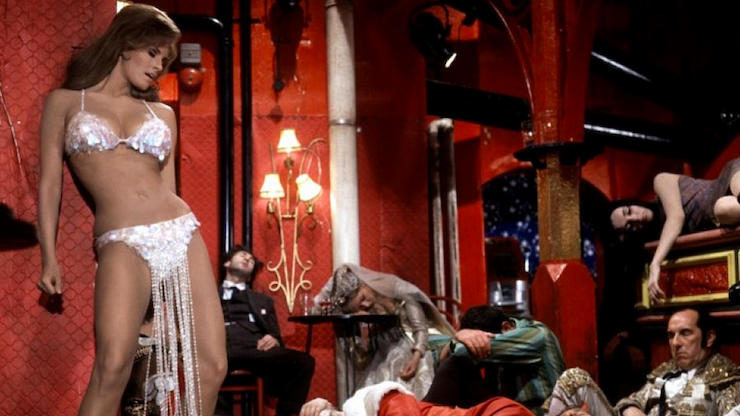
Though younger fans likely only remember the remake with Brendan Fraser and Elizabeth Hurley, the original Bedazzled starred the incomparable duo of Dudley Moore and Peter Cook as Stanley Moon and Satan (who goes by the name George Spiggott). Throughout the film, Stanley comes into contact with embodiments of the seven deadly sins—most notably Lust (above) and Greed—who work for the Devil and carry out acts of vandalism and so on. Though they are only tangental to the plot—where Moon agrees to sell his soul to Spiggott for seven wishes in an effort to get a waitress named Margaret Spencer to fall in love with him—the motley group provide a good portion of the film’s laughs.
The Sin du Jour Series by Matt Wallace
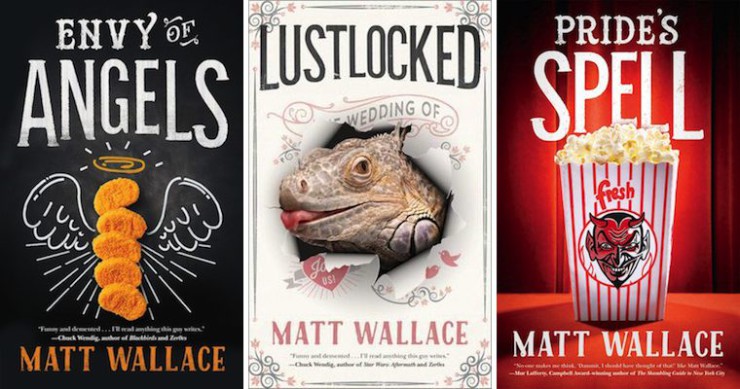
Named after the fictional Sin du Jour Catering & Events company, Matt Wallace’s series of novellas takes on the real world problems of chef pals Darren and Lena—who accidentally get jobs with Sin du Jour, not realizing that it’s a catering company for supernatural clients, demons included. The first three entries in the series have already been released, and the titles all play into the the catering company’s name: Envy of Angels, Lustlocked, and Pride’s Spell. In each tale, Lena and Darren get introduced to a new piece of the strange world they’ve inadvertently stumbled into, but they’re professionals, right? And every good chef knows how to roll with punches….
Gilligan’s Island
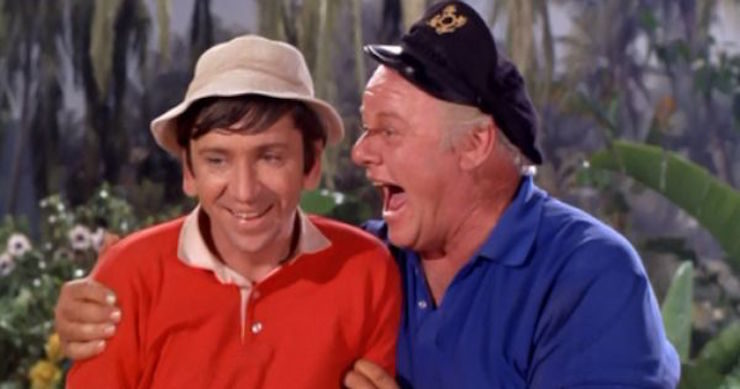
What is this doing here, you ask? Turns out, the show’s creator wrote a book called Inside Gilligan’s Island where he suggested that each of the castaways embodied a different sin. That seems an odd burden to saddle your shipwrecked central characters with, but it’s also a sharp way of ensuring conflict—if you’ve got someone who’s always Wrathful (Skipper) bouncing off of someone who’s always Slothful (Gilligan) you’re bound to come up with shenanigans. It probably helped a lot in sketching out scripts, just by keeping that as a constant reminder.
The Hannibal Lecter Series by Tom Harris

It has been said that each of the main figures in Harris’s series centered on Hannibal Lector and Clarice Starling represent one of the seven sins: Clarice and Hannibal themselves are Pride and Gluttony respectively. The other central antagonists of the series make up Envy (Jame Gumb), Lust (Francis Dolarhyde), and Wrath (Mason Verger). The detective Pazzi is said to be Greed (likely for agreeing to take the bounty on Hannibal for Verger), and Dr. Frederick Chilton becomes Sloth, using others to further his research while refusing to do the hard work himself. It is uncertain whether or not this was the interpretation that Harris intended, but the characters do seem to match up in a succinct manner.
Charmed — “Sin Francisco”
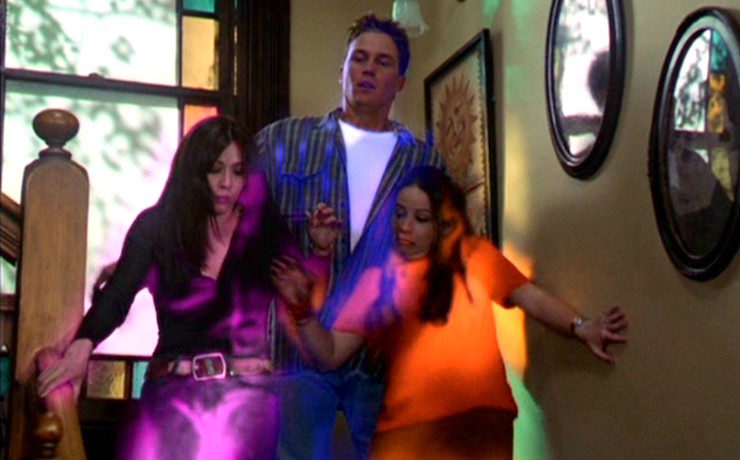
The show’s sister trio (and friends) got slammed with massive doses of sin… infections? That’s the easiest way of describing what happened when a demon came to town wielding very specific power. Leo got hit with Sloth while sisters Prue, Piper, and Phoebe got hit with Pride, Gluttony, and Lust respectively. Each person had to purge the sin by defying it, which on paper doesn’t seem all that clever. This episode wins points for putting an interesting spin on how the sin of “Pride” works, however; Prue couldn’t get rid of Pride so easily because doing so always turned into a show of how brave and selfless she was being—which is basically the embodiment of Pride.
Doctor Faustus by Christopher Marlowe
Christopher Marlowe’s The Tragical History of The Life and Death of Doctor Faustus features a parade of the Seven Deadly Sins. In this classic Elizabethan take on the story, Faustus sells his soul with the sensible goal of gaining knowledge forbidden to man. Mephistopheles, in a twist that Faust really should have seen coming, instead wastes his time, doesn’t teach him anything, and simply tries to tempt him with Earthly delights and distractions. Faustus spends the play whipsawing between repentance and gleeful sin, while a pair of angels goad him on. At one point he finally comes within a few heartfelt words of asking God to take him back, but Mephistopheles can’t let that stand, so he pops down to Hell and comes back with all Seven Sins in tow. They parade around Faust, who’s so excited to finally see some supernatural action that he misses the warning they represent.
They’re all pretty hilarious, but favorites go to Gluttony, who asks Faustus if he can stay for supper, and Sloth, who sighs, “I was begotten on a sunny bank, where I have lain ever since; and you have done me great injury to bring me from thence: let me be carried thither again by Gluttony and Lechery. I’ll not speak another word for a king’s ransom.” But naturally the best line goes to Lust (the only sin represented by a woman) who summarizers her Tinder profile for Faustus, saying, “I am one that loves an inch of raw mutton better than an ell of fried stockfish; and the first letter of my name begins with Lechery.”
There are plenty more examples, of course, from the obvious (Seven) to the not-so-obvious (Charlie and the Chocolate Factory, maybe?). Let us know your favorites in the comments!










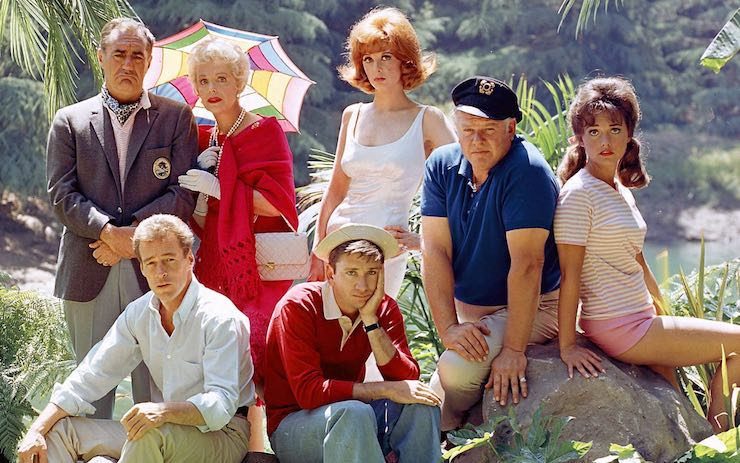
Fullmetal Alchemist was fun.
The reunion movie Rescue from Gilligan’s Island made the deadly sins connection explicit. When the castaways reunited near the end of the movie after going their separate ways back in civilization, the Professor commented on how each of the temptations and crises they’d faced had reflected one of the 7DS.
Fawcett’s classic Captain Marvel comics featured a censored version, the Seven Deadly Enemies of Man, as a group of demons imprisoned in statue form by the Wizard Shazam and occasionally battled and recaptured by Captain Marvel.
There’s a Star Trek prose anthology called Seven Deadly Sins, telling novella-length tales revolving around seven different antagonist cultures associated with each of the sins: Pride for the Romulans, Greed for the Ferengi, Envy for the Romulans, Wrath for the Klingons (by Tor.com contributor Keith R.A. DeCandido), Lust for the Mirror Universe, Gluttony for the Borg, and Sloth for the Pakleds (by Tor editor Greg Cox).
Now I’m trying to pair each of the castaways to one of the sins. Skipper: Wrathful; Gilligan: Slothful; Ginger: Lust(?); Mr. Howell: Greed(?); Mrs. Howell: Gluttony(?); Professor: Pride(?); Mary Ann: Envy(?).
I’m not sure if all those match up, especially Mrs. Howell & Gluttony, but that’s my attempt.
There’s a great webcomic, Widdershins, by Kate Ashwin–Victorian-era adventures mostly set in the eponymous town, which is the magical epicenter of England and one of the three worldwide anchors of magic. There have been manifestations of the Sins in every story, and the current arc has all seven of them trying to take over the town and the anchor. Great stuff!
In the first episode of the third season of “Supernatural” (titled nicely “The Magnificent Seven”), they are seven demons escaping Hell and possessing special powers unique to themselves.
#3 @gadget – I think you probably have it. My first instinct was to put Pride with one of the Howells, but I can’t see Gluttony going with any of the others and Pride does fit the professor well enough. Perhaps Greed and Gluttony are switched between the Howells, but those particular sins are closely related anyway. I could see Envy and Lust being switched, but that just might be me preferring Mary Ann to Ginger. ;-)
I’m not sure about Gilligan being Sloth. He seemed to work an awful lot on the show. But if you had a sin for incompetent . . .
@3/gadget: I think you’re right about the Gilligan correspondences. “Gluttony” literally means eating to excess, but in the Biblical sense it means any overindulgence or wasteful extravagance, or selfishness at the expense of others. Lovey Howell is the kind of person who brought half a dozen suitcases of clothes and jewelry on a 3-hour sightseeing tour and who obsesses over which outfit to wear to a campfire. I’d call that overindulgence. And though Lovey isn’t as selfish or insensitive to others as Thurston, she does tend to live in her own self-absorbed reality.
Although you could make the case that Lovey is the embodiment of Pride — in her social standing and refinement — while the Professor represents Gluttony for knowledge, though I don’t see how his pursuit of knowledge is wasteful or selfish.
As for Mary Ann and Envy, I suppose the idea is that she’s envious of Ginger’s looks and glamour, though that didn’t get played up much — and if you ask me, Mary Ann is the hotter of the two by a good margin.
Hmpf.
How about Se7en? What’s in the box!?!?
@3 ,@8, There’s more than one list of the Seven deadly sins – Sloth used to be Acedia (a complicated psychological state hard to explain here), for example. And Envy in the medieval sense isn’t quite the same as covetousness – for quite a long time, envy was understood to be not an unjust desire but the failure to rejoice in the good of another (paraphrasing Aquinas closely). Most current folks use envy to mean covetousness. I think Maryanne, though the most sympathetic character, was supposed to be envious in the older sense of the term.
if anyone’s read or watched Yu Yu Hakusho, the 7 psychics Sensui recruits for the apocalypse are based off the 7 deadly sins of man.
Gatekeeper/Itsuki=Lust
Sniper=Pride
Doctor=Wrath
Seaman=Envy
Gamemaster=Sloth
Gourmet=Gluttony
Elder Toguro=Greed
If I recall correctly, in the movie The Dark Crystal, the Skeksis stood for the Seven Deadly Sins and the Elders(?) were the Seven Virtues; they needed to be joined together to form a balanced whole.
Fullmetal Alchemist is the first one to come to mind. My inner fangirl makes happy noises just thinking of the seven homunculi. The series (I’m thinking of the original manga) is just so well written.
How does Se7en not make the list??
@2 – There’s a Justice League / Justice Society crossover where some of the heroes get possessed by the Seven Enemies of Man. Guess who possessed Power Girl…
Then, in the recent Pandora comic, Pandora let the sins out of their box and then spends her immortality hunting them down… with guns for some reason?
Also one of the Doctor Who: Short Trips short story collections is based around the Seven Deadly Sins.
A relevant anthology to this discussion is THE SEVEN DEADLY SINS OF SCIENCE FICTION (1980), edited by Isaac Asimov, Martin H. Greenberg and Charles G. Waugh. Incidentally, the following year they published THE SEVEN CARDINAL VIRTUES OF SCIENCE FICTION, which might suggest a companion post :-)
@15 might be a little on the nose.
Webcomic Kill 6 Billion Demons
KEYS TO THE KINGDOM YES YES YES.
I’ve been obsessed with this little-discussed series since I read it in 2014. This obsession is largely thanks to the titular villains. They do embody the Sins, in a way. But most of them were normal people (for that world’s non-human standards of “normal”) before they each became afflicted with a Sin which makes them suffer greatly even as it drives them to devastate their domains. I kind of hated them while reading the books,* as one should. But in retrospect, admittedly encouraged by fanfiction, I found them increasingly sympathetic, relatable, and bizzarely lovable in my twisty mind. It helps that the story’s corresponding embodiments of the Seven Virtues are quite obnoxious in their own ways, and I utterly hated them after they (rollover for a big spoiler) //DESTROYED THE HOUSE AND THE UNIVERSE///.
*Except Wednesday, who I have always adored beyond all reason. I consider her the patron goddess of House Manderly.
I suspect we could try tying up some of the central characters of WOT to such states of mind:
Rand – Pride
Mat – Lust
Perrin – Wrath
Egwene – Greed
Aviendha – Envy
Elayne – Gluttony
Though I suspect that some of the other characters would fit Pride quite well – Nynaeve and Lan, for example, and the High Lords of Tear are pretty much embodiments of of the entire list.
The Chronicles of Narnia. According to one theory, in each of the seven books the central conflict or designated villain can be identified with one of the Sins. And in The Voyage of the Dawn Treader, the fates of the missing seven lords of Narnia also reflect the seven sins.
Elayne is mentioned to love sweets, but Gluttony isn’t a major motivator for her. WoT doesn’t really have any particularly Gluttonous characters, except Mat in the post-Healing period when such greatness was thrust upon him. Many of the Forsaken are driven by varying blends of Pride, Envy, Wrath, and in some cases Lust.
I’ve heard that about Voyage of the Dawn Treader, but the correlations with the actual lords aren’t great. Greed draginized Eustace on Dragon Island, but this might or might not have happened to Lord Octesian. Greed for Goldwater Pool nearly made Edmund and Caspian fight each other Wrathfully, but since Lord Restimar appeared to have dived inro the pool, he presumably didn’t notice its goldifying ability before deciding to take a swim. The Three Sleepers recklessly ate at Ramandu’s table, but were actually put to sleep by the stone knife one of them grabbed out of Pride and Wrath. The Dufflepud episode was supposedly all about vanity, but I’ve embraced Ana Mardoll’s extensive opinion on the subject. One could suggest that Bern as Slothful for not ending the Lone Islands’ slave trade before Caspian and Co. did, but I dunno.
Charlie and the Chocolate Factory, yes. Augustus had Gluttony, Verruca had Greed (those are very different things, people!), Mike had Wrath, and Violet is more ambiguous.
I was gonna mention the Star Trek: Seven Deadly Sins anthology, but Christopher already did. :)
—Keith R.A. DeCandido
There’s also Fated by S. G. Browne.
http://sgbrowne.com/novels/fated/
It’s mostly about the rivalry between Fate and Destiny, but all the anthropomorphic personifications like Death and Luck show up as well. This includes the Seven Deadly Sins, mostly Sloth (a narcoleptic stoner) and Gluttony (who is lactose intolerant). The two of them have been hanging out together since the dawn of time.
It’s my favorite novel of his.
There is also a short story he did about what all seven sins were doing during Sodom and Gomorrah.
There’s a fun low-budget Belgian film called “Les Sept Péchés Capitaux” (1992), in which the deadly sins are actually things like ‘tenderness’, ‘honesty’, ‘modesty’ and so forth. As a bonus, it features Robert Mitchum as God: a cigar-smoking, English-speaking, thoroughly American God.
#3 is close to the list I made when I was brainstorming “Gilligan’s Inferno,” back in (maybe) the 90s. I had Skipper down for Sloth, and Gilligan for hatred, which he kept a secret, though his muttering sometimes gave it away. The seven sinful castaways would be doomed to spend their eternities in a series of dream episodes, where all the other characters were played by the other castaways.
Got to run. Consider yourselves lucky.
The video game Overlord, (written by Rhianna Pratchet) turns a lot of fantasy tropes on their heads. You play as an (evil) overlord, going after fallen heroes who each demonstrate one of the sins. It’s quite amusing, there’s a slothful elf, a envious rogue, lustful knight, proud wizard etc.
I can’t wait for Matt Wallace’s “Idle Ingredients ” which is book #4 in his 7 Deadly Sins series of “Sin Du Jour” stories! It drops in February – so I suggest you purchase the first three “Envy of Angels” “LustLocked” and “Prides Spell” now so you can be caught up when it ships!
Short video that is the best representation for the 7 Deadly Sins ever. Thanks, Studio C! ;)
A contemporary work to Marlowe’s ‘Faustus’ was Edmund Spenser’s use of the 7 deadly sins in ‘The Faerie Queene’.
@30: Uh-oh. I will soon visit a land renowned for its sloths. I must be wary.
On second thought, they can’t eat my soul, because the Drowned Goddess of Gluttony already did.
Greed (Avarice) makes only a tiny appearance in Bedazzled; my recollection is that the most screen time after Lust goes to Pride (here, Vanity), who has a mirror mounted so that what he most sees is his own appearance.
One of the most-remembered productions of Marlowe’s Faust was directed and starred in by Orson Welles, for the Federal Theater Project; IIRC, the Sins were portrayed by marionettes of Bil Baird, who was just starting to become well-known as a puppeteer.
As Cecilia says in #11, no one can agree on exactly what the Seven Deadly Sins are. They’ve changed over time and are different from region to region, religion to religion.
There are also minor variations which engender discussion. For instance, some people call it Anger, some Rage, some Wrath. These are all related by not the same. Rage implies loss of control, while Wrath has overtones of righteousness. Calling Anger a sin is common but seems counterproductive to having a healthy psyche. Unless you’re a Vulcan.
Hannibal fits better for Pride or Wrath than for Gluttony. Yeah, he eats people, but that’s not really his central motivation; proving his own superiority and punishing the disrespectful are what drive him